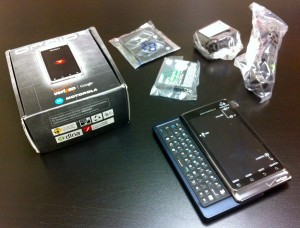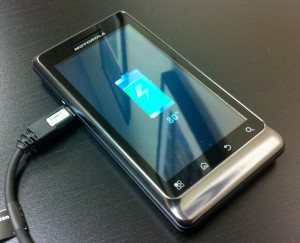 We have heard the “iPhone on Verizon in X months/years” often enough that everyone assumes that it will be true at some point in the future. There are plenty of theories, rumors, debates and denials as to when we may see this mythical unicorn. One thing is clear: Verizon doesn’t sell the iPhone today and there are plenty of people who want to buy that phone. My review is for those folks that have made the carrier (Verizon) the top priority in choosing a handset.
We have heard the “iPhone on Verizon in X months/years” often enough that everyone assumes that it will be true at some point in the future. There are plenty of theories, rumors, debates and denials as to when we may see this mythical unicorn. One thing is clear: Verizon doesn’t sell the iPhone today and there are plenty of people who want to buy that phone. My review is for those folks that have made the carrier (Verizon) the top priority in choosing a handset.
Here is the short version: If you are waiting for the Verizon iPhone, stop waiting. Get the Droid2.
That isn’t to say that Google’s Android OS is better than Apple’s iOS, rather, the two are different. I’ll refrain from the whole “open/closed” argument surrounding the two platforms; most people don’t care, they just want to use the gadget.
Day 1 with the Droid2
The day started with a delivery from Mr. FedEx. It didn’t matter that I had work to do, I couldn’t resist unboxing the phone, charging it to full, and subsequent play time. Immediately, I noticed that the Droid2 feels great in your hands: the buttons, slide out keyboard, corners/edges, etc. – everything seems well conceived. Compared to holding the original Droid, the Droid2 is more refined.
First step was to configure my Google Apps and Google Voice accounts. This was a relatively simple process (except for typing my crazy long passwords) and all of my email was instantly accessible from the Droid2 as well as all of the calendars and contacts from my Google account. The problem with Google contacts is this: I have a HUGE number of contacts because tons of people email me. Google adds these people to my contacts automatically, but most do not have phone numbers. As far as I could tell, I couldn’t easily filter my contacts to show only people with phone numbers.
First small task was to use the “Car” interface to navigate home, a simple 15 minute drive. Once I had the addresses set (do this before you get in the car), the route it planned was the same one that I typically drive. The voice synthesis was pretty good and voice prompts were timed well. For a free/built-in application, navigation is quite good. It isn’t as good as the TomTom app for my iPhone or a stand-alone Garmin or Magellan device, but these cost significant money and real-time traffic is extra. Once I arrived home, I turned off the GPS to conserve battery.
After dinner, I spent about 30 minutes playing with the Droid2: exploring email, enabling Skype, exploring the interface, and linking Facebook and Twitter to the “Social Network” notifications feature. Once I realized that connections from both Twitter and Facebook were being added to my phone as well, I unlinked them. The Twitter experience wasn’t particularly good and I didn’t want my Twitter contacts into the blended database of the phone.
At that point, the Droid2 showed 60% left of the battery. (Side note, the unit was noticeably warm, but not hot.) I turned the phone off completely for the night. No lights were flashing, no “DROID” sfx, it was off.
 Day 2 with the Droid2
Day 2 with the Droid2
The next morning, I powered on the device, turned on the GPS, entered the address of my office, and let it navigate me there. Midway through the drive, I got a notice (that I couldn’t read while driving) that the battery was at less than 10%. Really? Not even 30 minutes with GPS and less than 2 hours total usage and the device was dead? So I turned off the phone completely, and plugged it in to charge it, which took about 90 minutes to bring it to 100% charge when completely off. This seemed very strange, so I decided to repeat the experiment with one small change: I stopped the Skype application from running in the background. Sure enough, Skype turns out to be a battery hog. (Same problem with the Skype application on the iPhone.)
Doing basically the same as the first day, I found that I got around 5 hours of mixed use. You will want to keep the device charging in the car and on the desk whenever possible.
Over the next week, I continued to explore the device. I explored the application marketplace, downloaded applications, browsed websites and in general, made sure that I was comfortable with Android.
A day in the life…
After having ample playtime with the device, I wanted to get true field use. So I forwarded all of my calls to the Droid2, and with a fresh battery, put it into use exclusively for the day. (Yes, I powered down my iPhone completely.)
The call quality of the Droid2 is excellent. Without any prompting, a friend was quoted to say, “Wow, did you get a new phone? You sound really clear. Is this your new cell phone number?” Needless to say, Verizon customers typically tout this single feature as the most important of the bunch. The Droid2 delivers well.
Nothing dropped through the day. Even in my office, an inner office with no windows, calls came through without any problems.
Working with the email was very natural, especially since I’m a Google Apps customer. Everything was instantly in sync with my desktop experience without needing a sync cable.
During the day, I did have to power down the phone a couple of times. Once the touch screen became completely unresponsive, but the phone seemed to still be doing its thing. Another time, the phone seemed to be confused, wouldn’t download email, and actions were taking 10+ seconds to complete. The reboot solved all of the problems, but rebooting is something that I haven’t had to deal with since I traded my Treo 650 in for an iPhone.
I installed enough of my main use applications, which are available on both Android and the iPhone, so that I basically went through a typical day without feeling shorthanded.
I opened up the keyboard a couple of times, but tended to stick with the virtual keyboard more often than not. I just tend to be faster and I’m able to trust the software to assist with the typing.
Overall, the Droid2 made it through the day very well. At no time did I wish that I had my iPhone. I could totally see myself enjoying this phone everyday.
Mobile Hotspot
One of the advertised features of the Droid2 is the ability to use the device as a mobile hotspot. I’ve had a Verizon MiFi for a little over a year and find it very useful, so I was curious to see if I would get similar results for speed and connectivity. The Droid2 was easy to connect to and Speedtest.net gave me a 1.75 Mb/s download speed and .47 Mb/s upload speed. In comparison, the MiFi delivered 1.91 Mb/s download speed and .79 Mb/s upload. I repeated the tests about 5 times and I’m reporting the best speeds for both. Both were tested in my office side by side and the test was run on the same laptop and browser. The MiFi was marginally faster than the Droid2, a difference that can probably be explained by the presence of screens, GPS radios, and metallic enclosures.
Customization
One area that Android particularly shines is its ability to customize the application icons, system widgets and application widgets. I happen to be a person that will meticulously organize the experience to whatever makes me happiest. The Droid2 has 7 home screens for icons, widgets and animated wallpapers. I was able to put my most used applications on the center/default screen, while putting some weather, news and social network widgets on the other screens.
One thing to note, you need instructions to learn how to customize the home screens. Certain things about Android aren’t by any means obvious and you will want to read several tutorials to get more power and control over the device. (The iPhone has a couple of things that require minor instruction as well.)
Touch Screen
Visually, the screen is stunning, very similar to the iPhone4. Graphics are bright and clean. However, being used to an iPhone touch screen, I found that the Droid2 was a little sluggish in terms of response time. It might only be a quarter or half second, but it is enough to slow me down. When scrolling through a list, it didn’t respond as predicted, sometimes selecting and launching an application while I was trying to scroll. Also, the speed and inertia of the scrolling is a little strange to my taste. If you have never touched an iPhone, this might not bother you that much, but the iPhone does this extremely well and it is everywhere in the experience for both platforms.
I noticed a lot of errant touches, often just from wrapping my hand around the device. The touch buttons at the bottom of the screen are just a little too short for my fingers/hands, so when I thought I was tapping the home icon, I was opening the menu for all of the apps, and then launching something at random. Accessing the notifications at the top of the screen (new email, voicemail, text messages, etc.), I often found myself accidentally repositioning screen widgets when I was trying to access the notifications bar.
Physical Keyboard
I had chance to compare the physical keyboard of the new Droid2 with the original Droid. The new version feels much better with its raised bumps and more spacious layout from eliminating the d-pad from the original. I know a lot of people who cannot get used to a virtual keyboard, so the Droid2 keyboard will be very well received for those people.
Virtual Keyboard
I’m very used to using a virtual keyboard and found that I was much faster on the virtual keyboard than the physical keyboard. Android’s word prediction is very good, giving you plenty of words to select.
Camera Quality
The Droid2 has a 5MP camera with LED flash, similar to the iPhone4. The camera does a decent job with two minor exceptions. First, the Droid2 uses a strange aspect ratio for the image, rather than a standard 4:3. Second, photos from the Droid2 seem to lack depth and contain digital noise compared to the iPhone4.


Both of these photos were taken from the exact same point and with the phones using the table for support to minimize jitter. The Droid2 didn’t focus until I tapped the shutter, which caused it to zoom a little, losing the bottom of the image. Please note that both of the full size images (linked) are straight from the phones using the default camera application.
Interface Issues and the Back Button
I’ve used touch screen devices since the late 90’s, including the Palm Pilot, Handspring Visor, Treo 650 and then the iPhone; I’m very comfortable in this environment. Perhaps it is just me, but I never even thought about needing a “back” button. On Android, you cannot live without it. Also, Android has the “extra choices” button to get to all of the options and menu items, sometimes with additional sets of choices. This basically compensates for the differences in screen sizes and configurations, by hiding a collection of choices from the interface. (The iPhone has a standard user interface and screen dimensions as did the other devices previously mentioned, so this wasn’t an issue.)
Also, consider something as simple as the physical “OK” button and a virtual “OK” button. When you unlock the device and enter a password, you end the sequence with “OK.” If you enter the password on the touch screen, the “OK” button is virtual. If you enter the password on the physical keyboard, you tap the “Enter” key rather than the “OK” key, even though the interface says “OK.” This is a minor inconsistency, but if you put enough of these little details together, you realize that Android still has a long way to go before it matures. That said, a benefit of Android is that you actually get updates to the core software, so your phone will “get better” through the course of your contract.
Final Thoughts
The Droid2 is a phenomenal device – if the iPhone didn’t exist, the Droid2 would be king. But the iPhone does exist and shows its interface maturity over Android. One thing to be clear, Android is evolving at a blistering pace and I suspect that time will heal these minor issues, and they are minor issues. The Droid2 is a worthy competitor to the iPhone4 and it is on Verizon. If you are wanting to get a smartphone and you are a Verizon customer, get the Droid2.
In the interest of full-disclosure, I was provided a review unit at no cost. I was not asked to write a review for the phone and I was not compensated for writing this review other than free use of the phone. Also, I have arranged for the return the phone.
